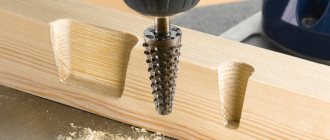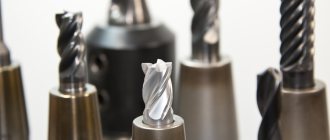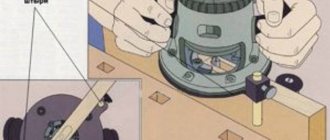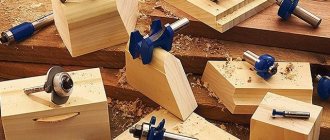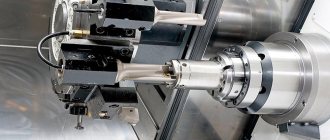A milling cutter is a cutting tool with which a manual milling machine or a stationary unit processes the surface of various materials (wood, plastic, metal). Since the equipment is designed for rotational movement, its basic shape will be disc-shaped or cylindrical. At the same time, the cutting edges of the tool can have a rather intricate shape. Hand milling cutters are divided into several types. The most common among them are for wood processing. At the same time, wood cutters also have their own classification. Let's look at what types of cutters are designed for processing wooden surfaces, and how to choose them correctly.
Slot cutters
If you need to select a groove of any depth and width, then a groove cutter is ideal for this purpose. Its design allows this operation to be performed both on the face (face) of the part and on its edge. A groove cutter is mainly used when joining parts into a tenon. Also, using attachments for a wood router that follow a ruler, you can cut even grooves of any width.
Shaped
They allow you to give the groove certain shapes, similar to curly braces. The tool not only selects grooves inside the workpiece, but also changes the shape of the edge ribs. When making a complex pattern on the surface of a workpiece, a straight cutter (groove) is first passed through it. In the future, this simplifies the alignment of the shaped equipment.
The following pictures show the main types of slotted router bits.
Structural
After processing the workpiece with this equipment, a groove is obtained that looks like a trapezoid (dovetail) or an inverted letter “T”.
This method of connecting parts is considered one of the most reliable, since the tenons are pushed into grooves of the same shape, and they cannot be separated by any other method.
V-shaped fillets
Although the word “fillet” refers to a semicircular notch or groove, V-cutters also fall into this category. The tool allows you to select not only vertical grooves, but also grooves at a certain angle. Also, a fillet cutter is often used for decorative carvings and changing the geometry of edges in furniture production.
Fillet
They have a rounded cutting part. If you look at the groove after it has passed through the section, it will resemble the letter “U”.
The cutter is used for decorative finishing of the edges and ends of wood products, creating complex patterns on the face of the workpiece or various fillet recesses (grooves) on the face of the product and on its edges.
Direct
This is the simplest tool, shaped like a cylinder. The groove obtained in the workpiece has a rectangular cross-section.
The equipment is most often used with plunge routers.
Straight groove (finger) cutters are used if you need to select a rectangular groove with a clean bottom, for example, for inserting door locks and hinges.
Edge cutters
In most cases, edge cutters have a thrust bearing. Thanks to it, it becomes possible to guide the tool along the template, processing the edges and edges of the workpiece.
Half-rod
The tool creates semicircular protrusions on the edges of workpieces.
If you use a half-rod cutter in combination with a molding or fillet cutter, you can make hinged joints. Half-rod tools are also used to produce round rods. In this case, the workpiece is processed on both sides.
Curly
These shaped cutters are also called multi-profile cutters. Depending on the tasks, the master can use part of the equipment profile or use it completely. In the second case, you will need to install the tool in a unit that has a power of at least 1600 W.
Fillet
Designed to give the workpiece ribs an internal radius or to make grooves with a circular cross-section.
Fillet cutters are equipped with one or two bearings, eliminating tool distortion.
Conical
Using cone cutters you can:
- chamfer the edge of the workpiece;
- decorate the edge of the tabletop;
- create an angular cut on the edges of the workpiece before gluing them (polygonal-shaped products can be obtained).
Also included in this category is an edge cutter with a blade angle of 45 degrees.
Folded
Used for cutting quarters and grooves of rectangular section. Thanks to the thrust bearing, the rebate cutter can be used on both straight and curved workpieces.
To adjust the groove depth, thrust bearings of different diameters are used.
The slotted disc cutter also falls into this category. With its help, a groove is cut in the workpiece for installing a T-shaped PVC edge.
Mouldings
Moulder cutters allow you to obtain an arched, straight, or shaped edge on a workpiece. Working with any part of the same equipment, you can:
- round the edge of the part;
- get a rebated edge;
- make a semi-rod protrusion;
- get edge with sponge;
- make decorative processing of the ribs, for example, making window frames.
You can also use molding cutters to create complex shaped ornaments on the edges and ends of a wooden part.
The equipment in this series can also be double, as shown in the following figure.
On a double cutter, the distance between the elements can be changed in accordance with the thickness of the workpiece. Thanks to two elements, the workpiece is processed in one pass, simultaneously on both sides.
Direct
A straight edge (overrunning or end) cutter is used for finishing the ends of a workpiece or creating an ideal 90 angle between the face of a part and its edge (end). The bearing can be installed at the top or bottom of the tool.
With the lower position of the bearing, the template is fixed under the workpiece, and with the upper position - above the workpiece.
In addition to the facing function, the equipment with the upper bearing can be used as a groove tool and cut a rectangular groove on the workpiece face, of course, using a template of a certain height. The diameter of the bearing is usually equal to the diameter of the tool, meaning it is flush with the cutting edge. But in some cases it is changed to a smaller or larger diameter in order to expand the capabilities of the equipment.
Milling cutter “corn”
The corn cutter is also an edging cutter. Its main purpose is to grind and align the edges of the workpiece according to the template. Thanks to the special arrangement of the knives (in a spiral), easy chip removal and smooth operation of the tool are ensured.
Combination cutters
Splicing workpieces is considered most effective if combined equipment is used. These types of cutters consist of both tenon and groove elements: thanks to this design, the equipment produces both profiles in one pass . As a result, the area of the edge intended for gluing increases, which has a positive effect on the strength of the connection.
Framework
Frame cutters are compound tools. All cutting elements are installed on the base, and the master can place them in the desired order. Set cutters have the following components:
- base;
- cutting elements;
- bearing;
- washer;
- fixing nut.
When changing the location of the cutting elements, it is not necessary to remove the shank from the collet of the unit. It is enough just to unscrew the fasteners located at the bottom of the equipment, and all its elements are removed. Thanks to the dismountable design of the equipment, the tool overhang remains the same, and re-adjustment is not required.
Tongue-and-mortise
The kit contains 2 cutters, one for making a groove, and the second for a tenon.
Tongue-and-mortise cutters have a mirror-identical profile of the cutting elements, thanks to which the processed parts are joined as accurately as possible.
The only disadvantage of this equipment is that the grooves and tenons are made with different cutters, which have to be changed and again their offset relative to the base of the unit must be adjusted.
For the manufacture of lining
In their operating principle, cutters for making lining are similar to a tongue-and-groove tool, but the only difference is that when connecting the parts, a V-shaped groove is formed between them to imitate timber. To make the connection, a set of 2 elements is also required.
Universal
After passing the tool, 2 planes are obtained, completely compatible with each other, having a groove and a tenon. Both of the latter are located at an angle to each other.
A microtenon cutter is also used to splice parts.
The equipment can be used both for longitudinal splicing of workpieces (in the manufacture of panels) and for end splicing of parts.
For corner jointing of wood, equipment from a series of combined ones is also used, which allows you to prepare joints at an angle of 45 degrees.
It should be noted that the same combination cutter is used to process workpieces that need to be joined. The original design of the equipment makes it possible to achieve maximum quality of joining of parts, and also significantly saves time, since there is no need to change the tool.
Figurine cutters
The tool is used in the manufacture of panels, namely for decorative processing of the edges of parts. All equipment has a thrust bearing fixed at the bottom. A cutter with a bearing can process not only rectangular workpieces, but also shaped ones. You should know that paneling tools have a diameter of 50 to 70 m, so in order to use them effectively, you must have a device with a power of at least 1500 W. For a household router, processing panels with this type of equipment will be an impossible task.
To make doors using a manual milling cutter (meaning kitchen facades), you will need to purchase a special set consisting of three elements.
The set contains the following facade cutters: one panel cutter and two accessories for furniture trim (profile-counter-profile).
Horizontal
Used for pre-treatment of panels. To form a tenon for insertion into the frame groove, additional processing of the edge will be required.
Vertical
Most often, vertical figurine cutters are used to make baseboards.
Horizontal double-sided
This type of equipment significantly simplifies the production process, since in one pass of the tool a connecting tenon and part of a panel of a certain configuration appears on the edge.
In addition to the above types of equipment, many craftsmen also use homemade cutters. They are usually standard plumbing drills, sharpened in a special way. You can learn how this is done at home from the video.
Criteria for choosing a cutting tool for wood
When choosing wood cutters for a manual unit, you should pay attention to the following equipment parameters.
Shank diameter and size
It should be taken into account that some foreign manufacturers of cutters may indicate the shank diameter in inches. In most cases, if a collet clamp is installed on the unit, then there will be no problems with installing the equipment, of course, provided that the diameter of the collet matches the diameter of the shank.
It is important to know that the collet of a hand-held unit is not a drill chuck into which you can clamp tools of different diameters . The inner diameter of the collet must strictly correspond to the diameter of the tool shank. Difficulties may arise if you buy equipment with a 1/2ʺ (12.7 mm) shank and try to insert it into a collet with a 12 mm diameter. At the same time, a shank with a diameter of 6 mm will be clamped in a collet at 1.4 inches (6.35 mm) without any problems.
Before purchasing a cutter, especially an expensive one, read the instructions for the unit and find out which collet is installed on it.
The length of the tool shank is also of great importance. Not all of them have elongated shanks, and sometimes their size is not enough to use the tool, for example, when expanding deep grooves. Also, long shanks of the equipment may be needed when securing the unit under the table. In this case, it is customary to use a cutter extension, which is clamped in the collet of the unit.
Blade material
This is an important criterion when choosing equipment. The product can be made of high-speed steel (HSS) or carbide (HM). High-speed steel blades easily cope with soft wood of low density. But these cutters are not suitable for processing hard wood. In this case, they can be replaced with equipment with carbide blades.
Location of cutting elements
The blades on the tool can be positioned vertically, that is, parallel to the axis of the shank, or at a certain angle to it. Vertically positioned blades work like a plane and cut wood more than they cut it. Therefore, if the blades are a little dull, they will leave marks on the surface they treated, which will have to be sanded.
Blades located at an angle to the axis of the tool work much cleaner and do not chip.
Features of working with a drill and cutter
Milling involves processing the material with a cutter installed in a stationary housing of the power device. In this case, it is assumed that the speed and depth of penetration into the processed material are regulated on the tool. But the array on which the action is performed must move. Such machines are called milling machines.
You can use a drill as a router only in certain cases. The reason is the special precision of work and the high force on the drive. Drill cutters are specially designed taking into account the power and methods of regulating the device. The shape of the drill and its center of gravity are of great importance for the work.
Features of using a cutter for a drill:
- a change in the load vector can damage the gearbox if additional pressure is applied to the workpiece;
- the motor overheats, frequent rest is required;
- the load on the plastic body can lead to armature misalignment and deformation;
- fastening in a chuck with a horizontal axis of operation is unreliable.
All this suggests that the drill as a milling cutter operates in an unusual position and with unusual directions of resistance forces. You need to work slowly and carefully with the milling attachment for a drill.
Stone cutters
To process artificial stone with a milling cutter (manual), you can use traditional types of cutters designed for wood, but only with carbide blades . There is one nuance here: artificial stone is a composite material containing tiny abrasive particles. Therefore, no matter what carbide material the cutter is made from, it will only be enough to process no more than 10 linear meters of stone workpiece. Further, dull blades will not provide the required cleanliness, for example, of the surfaces being glued, which will affect the quality of the joint.
Therefore, professionals advise using the best cutters from well-known manufacturers such as Festool, Leuco, Titman, Leitz, Dimar. The service life of cutting tools manufactured by these enterprises is 5-10 times higher than that of conventional carbide tools. With “branded” equipment it is already possible to process from 60 to 100 meters of composite.
Cutters for wood and stone are similar in appearance and even have the same names. Some of them are very often used for stone cutting operations. But there are cutters specifically designed for processing composite products.
Anti-overflow cutter
Using this stone cutter, you can create molding edges on kitchen (toilet) sinks and composite countertops. Typically, complete bead formation occurs in 2 passes of the tool.
There is also a modification of the cutter “anti-overflow”, which has a thrust bearing.
Wave cutter
This tool is designed to prepare surfaces before splicing. The cutting part of the equipment has a wavy profile.
Groove for inlay
Using the equipment, a groove is selected, which is subsequently intended for inlaying with composite materials.
Stone repair kit
This set is used to repair damage to the surface of artificial stone products. The set contains 2 elements. One makes the cork, and the second makes a hole for it.
You can also use cutters from CERATIZIT for processing composites.
These are diamond cutters that are distinguished by their wear resistance. They are made by sintering several layers of diamond chips. The multi-layer coating allows you to extend the service life of the tool, since during its operation new layers of abrasive appear to replace worn-out layers.
Colors of manicure cutters: what do they mean and how do they differ?
Like a file, each cutter has a certain abrasiveness. Cutters can be hard, medium, soft and very soft. How to determine their hardness? By the color of the notch at its base.
Black and purple notches
These colors indicate the hardest cutters. They are used only when processing and filing artificial material (extended nails). Such cutters are not suitable for manicure, as they are very rough.
Green notch
Green cutters are hard. They are used to remove artificial materials (acrygel, gel, acrylic). They are also used in pedicures to treat calluses. But in manicure they are quite rare.
Important!
This type of cutter is not suitable for working with sensitive skin or hyperhidrosis.
On cutters for removal, this color indicates large and medium notches.
Blue notch
This color indicates medium-hard cutters. They are used only for working on the outer areas of the skin. They are not suitable for working on the nail plate.
On cutters for removal, this color indicates the average cross-shaped and average straight-transverse notches.
Red notch
Red cutters are soft. They are used to work both on the skin and on the surface of the nail plate. They are the most versatile. They are usually used to clean out pterygium from the surface of the nail and in the lateral sinuses.
Important!
Have you come across a diamond cutter with two red notches? This means that it has increased softness.
On cutters for removal, this color indicates the middle cruciform-transverse notch.
Yellow notch
This color indicates soft cutters. They are used when working with sensitive skin and on the natural nail plate. On cutters for removal, this color indicates a fine cross-shaped notch.
White notch
White-knurled cutters are ultra-soft. They are intended for sensitive skin and minor nail work. Such cutters are not suitable for the everyday work of a craftsman, so they are used extremely rarely.
On removal cutters, this color indicates a fine spiral cut.
Metal cutters
There is no specially created metal equipment for a hand router. Typically, craftsmen use equipment designed for machine tools with a suitable shank diameter. Most often, end mills are used on hand-held units to create grooves. But you should know that the router is a high-speed machine, which is not very suitable for end cutters. Therefore, the metal must be removed in minimal layers, a few tenths of a mm thick, and in several passes. The following photo shows a spiral cutter for metal.
Also, milling cutters can be equipped with burrs of various configurations, which can easily cope with steel, cast iron, stainless steel, brass and even titanium. But since they most often have a small shank diameter (6 mm), an adapter will be required for installation in an eight-mm collet.
Burrs for metal come in the following types.
- Disk. You can make all kinds of cuts and process grooves.
- Conical (60°). Used for countersinking holes.
- Conical with reverse taper. The equipment is used for grinding grooves, processing sharp corners of the workpiece, removing welds in the corners of the product, and processing hard-to-reach holes.
- Conical with rounding. Used for processing joints, cleaning welds, and processing planes.
- Conical pointed. The tool can handle sharp corners, joints of parts, and also perform milling in hard-to-reach places.
- Oval. They process and expand holes, and also align welds in the corners of parts.
- Flame-shaped. Thanks to its universal shape, the tool is used for creating fillets, as well as for processing them.
- Spherical. The tooling can be used for machining holes, creating semicircular mates and machining grooves.
- Spheroconic pointed. You can process honey with planes connected at an acute angle.
- Spheroconic rounded. Mates with internal radii are processed.
- Spherocylindrical. You can process edges, profiles, welds, radius grooves. This equipment also removes chamfers and burrs and prepares the surface for welding.
- Cylindrical with a smooth end. Used for processing contours, seams after welding, edges, for chamfering and deburring.
- Cylindrical with teeth. Equipment with teeth on the end is used for the same purposes as equipment with a smooth end. Only this type of tool can work simultaneously in two planes at right angles.
Why do you need a drill on a magnetic bed?
When developing a drill on a magnetic bed, we were guided by the problem of creating holes in multi-ton metal structures that cannot be moved. Such trusses, like a large magnet, attract a pair with an opposite charge. Creating a charged frame for a drill solved the problem of securing a tool for drilling holes with high precision.
Drilling large cross-section holes in metal is carried out using different attachments, including using a milling cutter for a drill on a magnetic bed. Typically, this attachment is used in the form of a hollow crown. Drilling with a magnetic drill according to the markings is guaranteed to be accurate. As long as voltage is applied to the frame, the drill is held on the plane with a force of several tons per square centimeter. After turning off the current, the installation is easily moved to a new location; its weight does not exceed 25 kg.
A hole saw can be used to drill a hole in a structure up to 130 mm in diameter.
Accessories for hand router
The main task performed by various devices for this unit is to expand the functionality of the device. Some of the accessories are included with the device, but other attachments for the router must be purchased separately or made by yourself.
Rip fence
This device is included as standard with any router.
The stop allows you to make straight cuts on workpieces. The edge of the workpiece or the guide rail is used as a basic guide.
Guide rail
The tire acts as a guide along which the device stop moves. Using this device, straight-line milling of workpieces is performed.
Compass
This device is attached to the base of the unit and allows radial milling and cutting of circles.
Grooving
To select grooves of a certain width, use the milling device shown in the following figure.
The width of the groove is adjusted by one platform. In this case, a straight groove cutter with an upper bearing is used.
Copier
To transfer any complex ornament or pattern onto a workpiece, special devices are used - copiers (pantographs).
The copier works as follows:
- the workpiece is placed under the unit installed in the pantograph;
- the ornament or pattern that needs to be copied is placed at the required distance from the copier;
- The pantograph pointer is set to the initial position, after which the unit engine is turned on;
- all movements of the pointer along the pattern are accurately transmitted to the router, and it cuts out a copy of the required pattern on the workpiece.
Copy rings and template
The copy sleeve is needed, first of all, to protect the template from the impact of tool blades. In addition, the copying ring, moving along the edge of the template, transfers all its shapes to the cutter, which processes the part located under the fixture.
If the hole in the template exceeds the dimensions of the sole of the device, then it can be installed on a platform of suitable dimensions.
Processing bodies of revolution
This simple device allows you to cut transverse and longitudinal grooves in cylindrical workpieces (turned table legs, pillars, balusters).
Tenoning device
To make tenons for box joints, straight or dovetail, use a tenoning device.
The use of this attachment allows you to produce tenons with equal distances between them, so that the parts are connected in an ideal way.
Tenon-groove device
The tongue and groove connection is the most common in carpentry.
To make this connection, there are special devices called pantorouters.
Despite the apparent complexity of the design, this machine can be easily made with your own hands according to drawings, which are abundant on the Internet.
Router table
By installing a manual unit in a table, you get a stationary mini-machine. With its help, it is convenient to process small and long parts that cannot be clamped with clamps. There are ready-made milling tables on sale that are specifically designed for mounting hand-held milling machines. Below is a table produced by the Corvette company.
But as practice shows, most craftsmen prefer to make milling tables with their own hands, since their design is not complicated. The table for the router can be made from thick plywood or chipboard with a thickness of 16 mm or more.
Device for panels
If you cut an isosceles triangle, for example, from plywood, and attach it to the sole of the router, as shown in the following figure, you will get a simple device for processing door panels.
This overlay allows for additional decoration of already finished doors without disassembling them, without the use of templates.
Results
Above we have provided a ranking of the best bits for a hand router for 2022. Before deciding which set is best to buy, it is important to consider the following aspects:
- Pay attention to the material from which the blades are made. Carbide bits will last 50% longer than standard hardened steel (HSS) bits and can become dull due to heat and friction.
- How much a bat costs is an important indicator of quality. It's easy to find budget hand tool kits and order online from an online store or buy from your local supermarket. Unfortunately, the vast majority of them are disposable and are not effective for long-term use. On the other hand, novice carpenters need to have inexpensive consumables to gain experience.
It is important to avoid mistakes when choosing. The recommendations from the article will help you determine the appropriate kit option to meet your carpentry needs.
How to sharpen a cutter at home
Sharpening of a cutter should be carried out only after complete removal of carbon deposits and contaminants from its body and cutting elements . For these purposes, it is better to use a special cleaning liquid (shown in the figure below).
Apply the product to the cutting parts of the equipment and wait a few minutes for it to dissolve the carbon deposits. Then you should take a regular toothbrush and thoroughly clean the blades of any remaining dirt. After cleaning, you can begin the sharpening process itself. To carry out this operation at home, you will first need to purchase a set of diamond stones that differ in grain size.
For rough sharpening, bars with larger grains are used. But the process of straightening blades should always be completed by polishing with the finest abrasive.
To sharpen a cutter, follow these steps:
- Place the block on the edge of the table and moisten it with water. If necessary, fix the device;
- lay the equipment on the block so that its cutting edge is in contact with the block along its entire length;
- move the cutter along the emery with smooth movements with equal pressure, periodically wetting it with water;
- Make the same number of movements for each blade of the rig so that the edges are stitched evenly.
If the equipment prepared for sharpening has a thrust bearing, then it must be removed before starting the process.
Of course, if there is such an opportunity, it is better to take the cutter to a specialized workshop for sharpening, where it will be restored using precision equipment. This procedure is inexpensive when compared to the cost of diamond stones.
Milling concrete with a drill
If there is a need to process the structure with a concrete cutter for a drill, diamond core bits with external cutters are used. The cutter is unscrewed from the base, shank. The pobedite layer cleans the hole well, provided the powerful drill operates in non-impact mode. These crowns are used for removing ceramic tiles from the wall for finishing cleaning.
Using pobedit bits for drilling is fraught with danger. The drill must be held firmly, expecting a jerk, since the density of the material in the wall may change, and the force of the impact will create a blow.


